








Irish Seisiún Newsletter
Thanks to our past editors - Mary Gallacher and Bill Padden
and Bill Padden
Editor Tommy Mac 
............
....Today's date and new proverb
To All Session Players
We'll give you a break to practice the previous sets
However, there was a change to our Christmas Eve Set
Click the link below to check it out.
Sunday's Seisiún
for June 29, 2025
‘Tá dúil ár n-anama sa cheol againn.’
Music is our soul’s desire.
.......Thanks again to
Bob Murphy, Pat Quinn, Randy Powell, Art Jacoby, and Kevin Westley
for supplying photos and info about our sessiuns.
Hi Tom,
Here are the tunes played today.
Musicians, Art, Pat Q, Anita, Anne Dillon (on tin whistle),
Grace Kildare's Fancy, Chair O'Neils, Give me Your Hand, South Wind, Lord Inchiquin, Garrich's Wedding Set. Dusty Windy Sills Set Frank's Reel Set Father Kelly's Set Tarboltin Set Garrett Barry's Set Lark in the Morning set (including Stan Chapman)
Art
Click any of the above logos to go to that site
.
 "That’s
How I Spell Ireland"
"That’s
How I Spell Ireland"
Saturdays at 7 to 8 PM EST.
You can listen on 88.7FM or WRHU.org.
For a request please text me on 917 699-4768.Kevin and Joan Westley
Note: Show will be preempted whenever the NY Islanders have a Saturday game
![]()

Finnegan's Events
Check out their calender
They support us - Let's support them
![]()

E-Mails Received
![]()
Old Ireland
,%20Co%20Antrim.%201935..jpg)
Slemish (Slieve Mish),
Co Antrim.
1935
![]()

Ireland Travel
Click below to view Waterford
from the De La Por Tower
Once playing, click the
speaker symbol for music. ![]()
Note: Whenever clicking on a link you will be brought to another web-site. To return here you must click on the BACK arrow.
![]()
Travel Quiz
Can you identify this site and it's location in Ireland?
Answer in next week's Newsletter
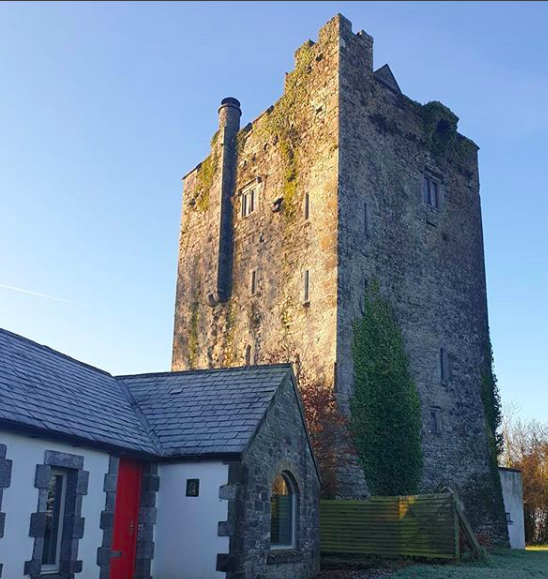
Last weeks Travel Quiz answer
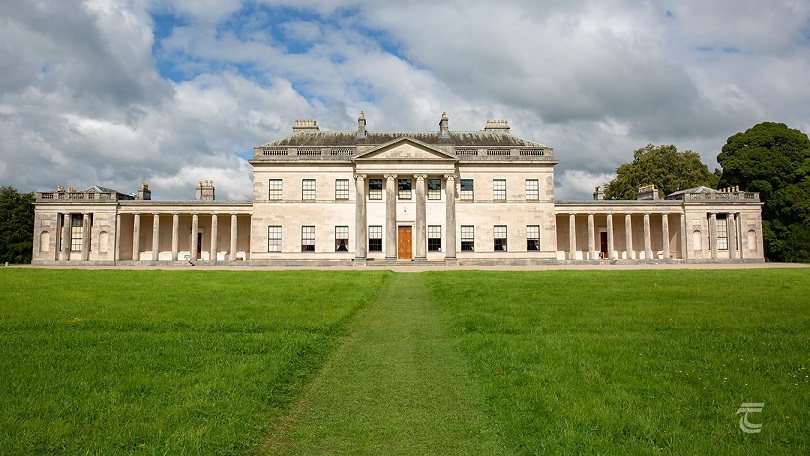
Castle Coole •
Fermanagh
![]()
Irish Language
Submitted by our own Anita
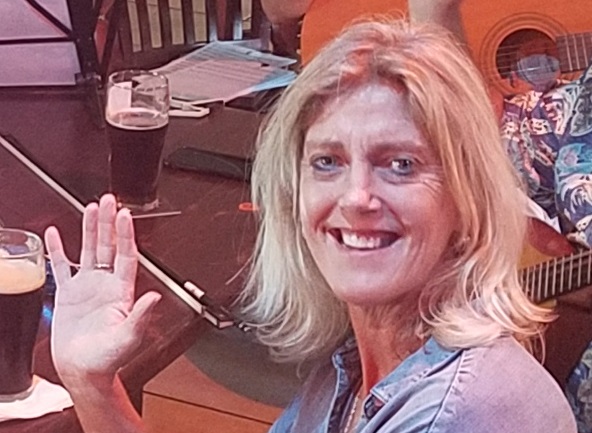
THE WORDS FOR NUMBERS DEPEND ON
WHETHER YOU'RE COUNTING HUMANS OR NON-HUMANS
In addition to one set of numbers for doing arithmetic or referring to dates and times, Irish has a second set for counting humans and a third set for counting non-humans.
Five children is "cúigear páiste," but five horses is "cúig chapall."
So the number 5 can be cuig (cooig) for dates and times, cuigear (cooiger) for people and cuig (cooig) for non-humans.
The number 2 is do (though) for dates and times but beirt (berch) for people.
Slan agus beannacht
Anita
(nulag huna duit)
Have you ever wondered what something would sound like when spoken with an Irish accent?
I'm sure you've come across that problem before in your ancestry research.
With a website like Abair, now you can hear anything you want in an Irish accent!
Free Irish Classes
The classes are over zoom and are held at 12:00 eastern time the 1 st Sunday of every month.
It is basic conversational Irish and open to learners of all ages, especially beginners.
All are invited.
Hope to see you there!
slan go foill. Le dea ghui,
Anita
click here to register
![]()
 ..
..
Apple crumble cake recipe from Irish chef
Donal Skehan Irish chef Donal Skehan shares his recipe for a traditional Irish apple crumble cake and shows us exactly how he makes it.
Donal Skehan @DonalSkehan Jun 20, 2025
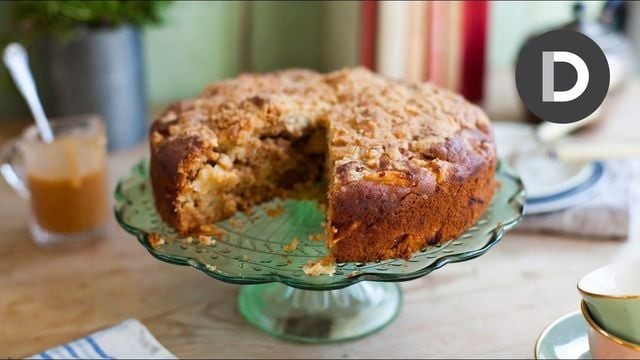
Delicious homemade Irish inspired recipes from chef Donal Skehan. Donal Skehan
Looking for a tasty dessert that is perfectly Irish? This traditional apple crumble cake recipe from one of Ireland's favorite chefs is your only answer. As Donal Skehan says himself: "Apple crumble is one of my most favorite desserts of all time," Donal Skehan reminisces.
"I remember making it growing up and to this day still swoon at the smell of it coming out of the oven. "This Irish apple crumble cake is a nice little twist on the classic with a moist apple cake interior and a light crumbly topping. That classic combination of apple and blackberries could also be used here."
Chef Donal Skehan's Irish apple crumble cake dessert recipe Serves 6-8
Ingredients
4oz butter plus extra for greasing
5oz soft light brown sugar
2 large free-range eggs
7oz plain flour, sifted
1 tablespoon baking powder
pinch of salt
1 teaspoon ground cinnamon
11oz peeled, cored and sliced cooking apple (Shouldn't be more than one large one)
For the crumble topping:
2oz of vanilla sugar (or substitute with caster sugar) "
2oz of plain flour "
2oz of butter
Method
Preheat the oven to 360°F, grease and line an 8in cake tin with a removable base. With an electric hand mixer, beat the butter and sugar in a large bowl until pale. Add the eggs, one at a time, mixing until they are incorporated.
Fold through the flour, baking powder, salt, and cinnamon until you have a thick cake batter. Stir through the apple and pour the batter into the cake tin. The batter will be thick, so use a spatula to spread it across the base of the tin.
Using a hand blender with a food processor attachment, blitz the ingredients for the crumble topping until you get left with rough crumbs. You can also do this by hand in a bowl using your fingertips to combine the ingredients. Sprinkle the crumble topping on top of the batter.
Bake in the oven for 40-45 minutes or until a skewer inserted into the center comes out clean.
Remove from the oven and leave to cool.
Donal demonstrates how to make this delicious crumble in the video below.
Check out his Facebook page and website for more culinary tips, recipes, and food travels. *Originally published in August 2016, updated June 2025.
Enjoy

If you have a cherished family Irish recipie share it with us.
And if there's a story that goes with it.....even
better! mail click here ![]()
Fireny@aol.com
![]()
filíocht pronounced FILL-ee-uhkht meaning Poetry

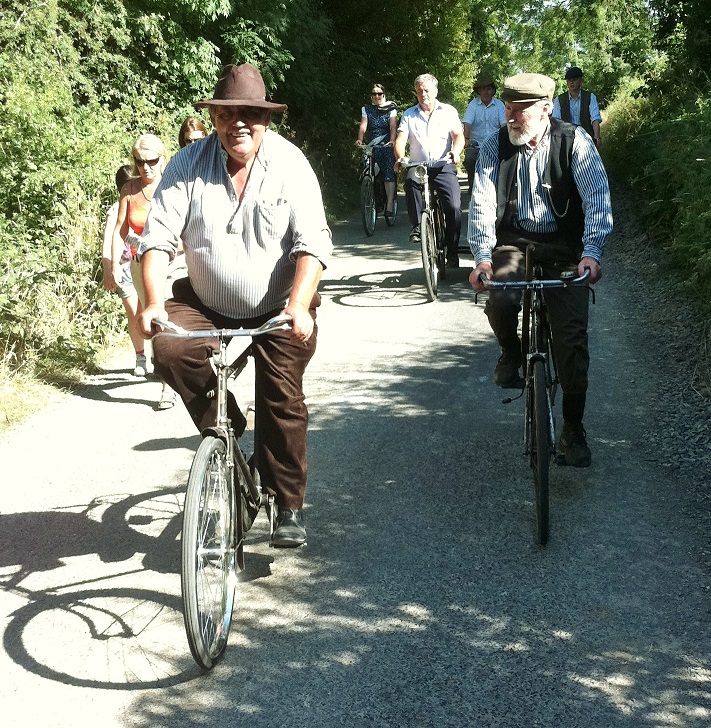
Inniskeen Road: July Evening
by Patrick Kavanagh
The bicycles go by in twos and threes -
There's a dance in Billy Brennan's barn to-night,
And there's the half-talk code of mysteries
And the wink-and-elbow language of delight.
Half-past eight and there is not a spot
Upon a mile of road, no shadow thrown
That might turn out a man or woman, not
A footfall tapping secrecies of stone.
I have what every poet hates in spite
Of all the solemn talk of contemplation.
Oh, Alexander Selkirk* knew the plight
Of being king and government and nation.
A road, a mile of kingdom, I am king
Of banks and stones and every blooming thing.

*"Oh, Alexander Selkirk knew the plight
Of being king and government and nation."
A reference to the castaway Alexander Selkirk who was imoortalised by Daniel Defoe as "Robinson Crusoe"
This poem, set in rural Ireland, captures the
tranquility of a summer evening. The poet 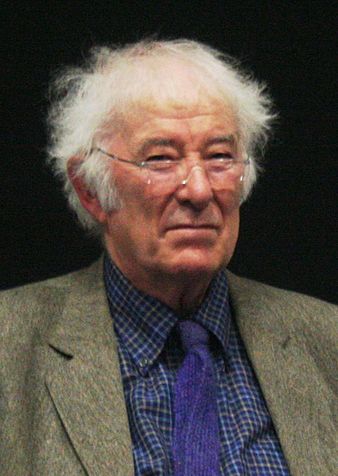 observes
bicycles carrying people to a dance at Billy Brennan's barn, hinting at the
excitement and camaraderie of the occasion.
observes
bicycles carrying people to a dance at Billy Brennan's barn, hinting at the
excitement and camaraderie of the occasion.
The absence of human presence in the second stanza evokes a sense of solitude and stillness, contrasting with the lively atmosphere of the dance. The poet's identification with Alexander Selkirk, a castaway who became a king on his deserted island, suggests his contentment in his solitary reign over the road and its surroundings.
Compared to the author's other works, the poem exhibits a more serene and contemplative tone, showcasing his ability to find poetic beauty in the ordinary. Set against the backdrop of the early 20th century rural Irish lifestyle, the poem reflects the simplicity and communal spirit of the time period.
![]()
Stories and Tales

"seanchaí"
(pronounced "shan-a-key")
comes from the Irish words "sean" meaning old and "caí" meaning to tell.
Tea drinking in Ireland
was once viewed as "reckless and uncontrollable"
19th-century reformers felt that peasant women in Ireland needed to 'stamp out' tea drinking to improve the Irish economy and society.
IrishCentral Staff @IrishCentral Jun 21, 2025

Poor women who drank tea were viewed as irresponsible as whiskey drinkers in early 19th-century Ireland, research by Durham University unearthed in 2012.
In her 2012 journal article "'A Raking Pot of Tea': Consumption and Excess in Early Nineteenth-Century Ireland," Dr. Helen O'Connell of Durham University found that critics at the time declared that the practice of tea drinking - viewed as a harmless pastime in most past and present societies - was contributing to the stifling of Ireland's economic growth, and was clearly presented as reckless and uncontrollable.
Women who drank tea wasted their time and money, it was said, drawing them away from their duty to care for their husbands and home. It was felt this traditionally female responsibility was vital to progressing the national economy. (I mentioned this to my wife. I should be getting out of the hospital tomorrow....Tommy Mac)
Pamphlets published in England at the time suggest that the concerns about tea drinking were also felt widely outside Ireland. Some believed it threatened the wholesome diet of British peasants and symbolized damage to the social order and hierarchies.
According to the paper that was published in the academic journal Literature and History in December 2012, reformers singled out tea drinking amongst peasant women as a practice that needed to be stamped out to improve the Irish economy and society.
Dr. O'Connell, who analyzed pamphlets and literature from that time, said: "Peasant women were condemned for putting their feet up with a cup of tea when they should be getting a hearty evening meal ready for their hard-working husbands.
"The reformers, who were middle to upper-class, were trying to get the peasant women to change their ways, albeit in a somewhat patronizing way, for the greater good of the country.
"The reformers made it clear they saw tea-drinking as reckless and uncontrollable."
Pamphlets the reformers distributed to peasant households lambasted tea drinking as a luxury poor women could not afford and which could even cause addiction, illicit longing and revolutionary sympathies.
It was also said that tea drinking could even be akin to being a member of a secret society, a belief that heightened political anxieties at a time of counter-revolution within the Union of Britain and Ireland.
English reformers were equally worried about sugar -- tea was always sweetened then -- and its connotations with slavery and the controversial plantations of the West Indies.
Dr. O'Connell said: "The prospect of poor peasant women squandering already scarce resources on fashionable commodities such as tea was a worry but it also implied that drinking tea could even express a form of revolutionary feminism for these women.
"If that wasn't enough, there were also supposedly drug-like qualities of tea, an exotic substance from China, which was understood to become addictive over time.
"It is unsurprising that tea consumption would generate considerable anxiety in Ireland in this period."
One pamphlet in 1811 by reformer and writer, Mary Leadbeater, tells the story of two female friends. Rose warns her friend Nancy that 'must not every poor man's wife work in and out of doors, and do all she can to help her husband? And do you think you can afford tea, on thirteen pence a day? Put that out of your head entirely, Nancy; give up the tea for good and all.'
*Originally published in 2012, updated in June 2025.
![]()
Dessie Hynes & Frankie Scorr -
The Ramblin House
The Rambling house is not gone!
It's at Tim Finnegan's almost every Sunday afternoon from 1PM to 3 or 4 PM in Delray Beach
Stop by, have a meal, the best pint in Florida, and enjoy the music!
![]()
Céad Míle Fáilte
and welcome to your Letter from Ireland
Summer has fully embraced us here in County Cork, with hedgerows bursting with honeysuckle and foxgloves and the evenings stretching gloriously as we move through the solstice. How are things in your part of the world today?
I'm sipping on a cup of Barry's tea as I write, and I hope you'll join me with whatever you fancy as we start into today's letter.
Just yesterday afternoon, I took a stroll past an ancient hawthorn standing beside a Holy Well. Colourful ribbons and trinkets hung from its branches – modern offerings to the fairy folk and whatever other spirits who claim these trees as their own. The farmer told me he'd never dream of cutting that tree down. "Some things," he said quietly, "are best left undisturbed."
This reminded me that for generations of rural Irish people, the fairy folk, or the "Good People" as they were respectfully called, were seen as a real and sometimes dangerous presence that shaped their lives. And no time was more charged with fairy power than these bright June days around midsummer and St. John’s Eve.
Already a Green Room Member? You can both read and comment on this letter in the Green Room forum here.
The June Threshold Between Worlds
The summer solstice in the northern hemisphere (around June 21st) and St. John’s Eve (June 23rd) were considered times when the veil between our world and the Otherworld grew thin. The Good People were seen as particularly active during these bright summer days.
Communities would light massive bonfires on hills, providing protection from malevolent fairy influence while honouring the ancient powers of the land. Farmers would drive their cattle between two fires for protection and carry burning embers home to light their hearth fires anew. They watched for processions of the fairies traveling along invisible fairy paths, and many an illness was attributed to blocking these routes.
The Irish relationship with the fairy folk was pragmatic coexistence. The quality of milk and dairy were particular concerns, careful farmers' wives would always spill a few drops of first milk on the ground as an offering. Fairy forts were strictly avoided, especially at midsummer, and farmers would plow around them.
The Hawthorn and Summer Fairies
Hawthorn trees, blooming gloriously around us through the month of May, were considered sacred to the fairies. Even today, road planners divert highways around them rather than risk misfortune. The scent of hawthorn blossoms was considered dangerous if brought indoors, as it might attract unwelcome fairy attention.
While many beliefs have faded, they remain embedded in our landscape. Fairy trees still stand untouched in fields. Farmers still plow around ancient fairy forts. In some communities (like here around Cork City), St. John's Eve bonfires continue as cultural celebrations.
These traditions reflect a profound relationship between people and place, acknowledging unseen powers in the landscape. Our shared Irish ancestors saw themselves not as masters of the land, but as participants in a complex web of visible and invisible relationships.
So, the fairy lore of June reminds us that the Irish landscape is layered with meanings and memories. Behind whatever we see lies a spiritual topography that was navigated as carefully as the hills and valleys themselves. Perhaps there's wisdom in this older way of seeing – recognising that not everything should be controlled, that some mystery should remain.
As the summer solstice is upon us here in Ireland, I think of those farmers lighting their protective fires and making their cautious offerings. And perhaps, as I pass that hawthorn tree again, I might leave a small token – not from superstition, but in acknowledgment of these enduring traditions that connect us to our land and past.
How about you? Have you any family stories of fairy beliefs or midsummer customs?
Do enail me at Fireny@aol.com to let me know....Tommy Mac
That's it for this week,
Slán for this week,
Mike.
![]()
The son of Irish immigrants
who led to the capture of Abraham Lincoln's killer
US President Abraham Lincoln was assassinated on April 14, 1865. Twelve days later, Irish American hero Edward P. Doherty tracked down John Wilkes Booth.
IrishCentral Staff @IrishCentral Jun 12, 2025
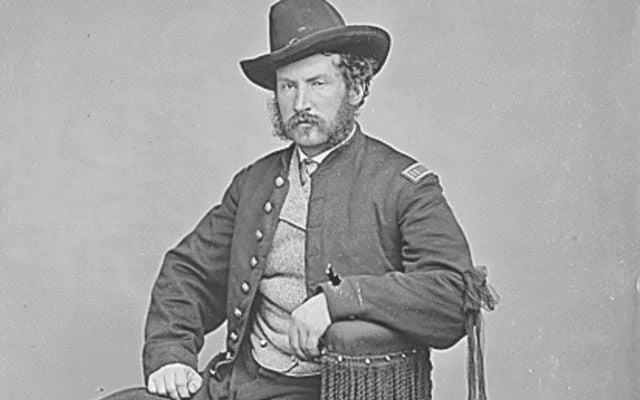
Capt. Edward P. Doherty, captor of John Wilkes Booth, c. 1860 - 1865. United States National Archive / Public Domain
On April 26, 1865, Edward P. Doherty, one of the unheralded heroes of Irish American history, tracked down and killed Abraham Lincoln's assassin, John Wilkes Booth.
Most people will know the name John Wilkes Booth, the man who assassinated America's 16th President Abraham Lincoln, on April 14, 1865, but how many know the name of the Irish man who cornered the villain?
Edward P. Doherty is one of the unheralded heroes of Irish American history, the man who tracked down Lincoln's assassin John Wilkes Booth. He was fiercely and proudly Irish, enlisting in the Irish Brigade during the Civil War. He was born September 26, 1838, in Wickham, Canada East, to immigrant parents from County Sligo.
He came to New York in 1860 and was living there when the American Civil War broke out. He enlisted in a 90-day militia unit and was assigned as a Private to Company A of the 71st New York Volunteers on April 20, 1861. He was assigned to Colonel Ambrose Burnside's 2nd Brigade in Brigadier General David Hunter's 2nd Division, he was captured by the Confederates during the First Battle of Bull Run, the first major land battle of the American Civil War which took place on July 21, 1861, near Manassas, VA. While a prisoner, he made a daring escape. Ultimately, the 71st Regiment, along with Doherty, mustered out on Aug 9, 1861.
Doherty went on to become a Captain in the Corcoran Legion, formed by fellow prisoner from the First Battle of Bull Run, Irish-American General Michael Corcoran, who was a close confidant of Abraham Lincoln. Doherty served for two years before being appointed First Lieutenant in the 16th New York Cavalry on Sep 12, 1863. The regiment was assigned to the defense of Washington, D.C. for the duration of the war, where Doherty distinguished himself as an officer.
Doherty's path crossed with John Wilkes Booth, the man who assassinated President Abraham Lincoln after the war was over. According to Eyewitness to History.com on the night of April 14, 1865, Booth shot the president and then fled the screaming pandemonium he had just created by flinging himself over the wall of the Presidential Box at Ford's Theater. Behind him lay an unconscious and dying President Lincoln, a .50 caliber bullet lodged in his brain.
As he plummeted through the air, Booth caught his foot on the bunting decorating the front of the presidential box, lost his balance and crashed onto the stage floor below. Ignoring the pain from his broken left leg, Booth, ever the actor, hobbled to his feet and ran to the back of the stage, stopped and delivered his last line on stage, "Sic Semper Tyrannis." (Thus always with tyrants.) Booth then disappeared into the night.
Booth fled south on horseback and, after meeting with one of his co-conspirators, David Herold, collected a stash of supplies from the Maryland inn run by a woman named Mary Surratt. With his leg in need of medical attention, Booth and Herold went to the house of a Dr. Samuel Mudd to have his leg set. After Mudd ordered them off his property, they were briefly helped by a variety of Confederate soldiers and sympathizers as they made their way towards the Potomac to cross into Virginia. Once across, they sought refuge in a barn on the farm of Richard Garrett.
It was there almost two weeks after Lincoln was shot that Union soldiers of the 16th New York Cavalry found Booth and Herold.
The following is Lt. Edward P. Doherty's account of what happened, which Eyewitness History adapted from an article Doherty wrote for Century Magazine in 1890, titled "Pursuit and Death of John Wilkes Booth".
The Account of the Officer in Charge
On April 24, 1865, Lieutenant Edward Doherty sits on a bench across from the White House conversing with another officer. The arrival of a messenger interrupts the conversation. The messenger carries orders directing Doherty to lead a squad of cavalry to Virginia to search for Booth and Herold. Scouring the countryside around the Rappahannock River, Doherty is told the two fugitives were last seen at a farm owned by Richard Garrett. Doherty leads his squad to the farm arriving in the early morning hours of April 26.
"I dismounted, and knocked loudly at the front door. Old Mr. Garrett came out. I seized him, and asked him where the men were who had gone to the woods when the cavalry passed the previous afternoon. While I was speaking with him some of the men had entered the house to search it. Soon one of the soldiers sang out, 'O Lieutenant! I have a man here I found in the corn-crib.' It was young Garrett, and I demanded the whereabouts of the fugitives. He replied, 'In the barn.' Leaving a few men around the house, we proceeded in the direction of the barn, which we surrounded. I kicked on the door of the barn several times without receiving a reply. Meantime another son of the Garrett's had been captured. The barn was secured with a padlock, and young Garrett carried the key. I unlocked the door, and again summoned the inmates of the building to surrender.
"After some delay Booth said, 'For whom do you take me?'
"I replied, 'It doesn't make any difference. Come out.'
"He said, 'I am a cripple and alone.'
"I said, 'I know who is with you, and you had better surrender.'
"He replied, 'I may be taken by my friends, but not by my foes.'
"I said, 'If you don't come out, I'll burn the building.' I directed a corporal to pile up some hay in a crack in the wall of the barn and set the building on fire.
"As the corporal was picking up the hay and brush Booth said,
'If you come back here I will put a bullet through you.'
"I then motioned to the corporal to desist, and decided to wait for daylight and then to enter the barn by both doors and over power the assassins.
"Booth then said in a drawling voice. 'Oh Captain! There is a man here who wants to surrender awful bad.'
"I replied, 'You had better follow his example and come out.'
"His answer was, 'No, I have not made up my mind; but draw your men up fifty paces off and give me a chance for my life.'
"I told him I had not come to fight; that I had fifty men, and could take him.
"Then he said, 'Well, my brave boys, prepare me a stretcher, and place another stain on our glorious banner.'
"At this moment Herold reached the door. I asked him to hand out his arms; he replied that he had none. I told him I knew exactly what weapons he had. Booth replied, 'I own all the arms, and may have to use them on you, gentlemen.' I then said to Herold, 'Let me see your hands.' He put them through the partly opened door and I seized him by the wrists. I handed him over to a non-commissioned officer. Just at this moment I heard a shot, and thought Booth had shot himself. Throwing open the door, I saw that the straw and hay behind Booth were on fire. He was half-turning towards it.
"He had a crutch, and he held a carbine in his hand. I rushed into the burning barn, followed by my men, and as he was falling caught him under the arms and pulled him out of the barn. The burning building becoming too hot, I had him carried to the veranda of Garrett's house.
"Booth received his death-shot in this manner. While I was taking Herold out of the barn one of the detectives went to the rear, and pulling out some protruding straw set fire to it. I had placed Sergeant Boston Corbett at a large crack in the side of the barn, and he, seeing by the igniting hay that Booth was leveling his carbine at either Harold or myself, fired, to disable him in the arm; but Booth making a sudden move, the aim erred, and the bullet struck Booth in the back of the head, about an inch below the spot where his shot had entered the head of Mr. Lincoln. Booth asked me by signs to raise his hands. I lifted them up and he gasped, 'Useless, useless!' We gave him brandy and water, but he could not swallow it. I sent to Port Royal for a physician, who could do nothing when he came, and at seven o'clock Booth breathed his last. He had on his person a diary, a large bowie knife, two pistols, a compass and a draft on Canada for 60 pounds."
Booth's body was carried up the Potomac and buried beneath the floor of a penitentiary in Washington, DC. David Herold was tried with three other conspirators. All were found guilty, including Mary Surratt, owner of the tavern where Booth stopped, were hanged on July 7, 1865.
After the war, Doherty set up a business in New Orleans before returning to New York, where he worked as Inspector of Street Pavings until his death in 1897 at the age of 59. In his later years, he was twice Grand Marshal of the Memorial Day parade and resided in Manhattan at 533 West 144th Street. He is buried in Arlington National Cemetery.
*Originally published in 2016, updated in June 2025.
![]()
5-Tune Friday
Hi Thomas,
Paraic here with this week’s Five Tunes!
From iconic session staples to trad-fusion gems and majestic minor-mode reels, this week’s lineup brings a lovely blend of old favourites, clever arrangements, and player-friendly versions. Whether you're adding something new to your set or just soaking in some top-class playing, there's plenty to enjoy here.
So then, let’s get started!
![]()
"Music For A Found Harmonium" – Reel
A tune played around the world, "Music For A Found Harmonium" has become a classic in the trad scene, despite its more modern origins. Composed by Simon Jeffes and performed here by him and the Penguin Cafe Orchestra, this tune blends traditional Irish rhythm with contemporary textures, making it a favourite for trad-fusion sets.
"Music For A Found Harmonium" – Reel
![]()
"Rosemary Lane" – Jig
A lovely, upbeat jig to keep the energy high, "Rosemary Lane" is full of bounce and spirit. This one sits beautifully on the accordion and brings great warmth to a mid-set lift. You can hear it here, played by Pat Barton.
"Rosemary Lane" – Jig
![]()
"The Broken Pledge" – Reel
A classic and powerful reel, "The Broken Pledge" is a firm session favourite. Its strong phrasing and driving rhythm make it a great tune to work on both pace and lift, and this is a gorgeous version by Benoît Volant.
"The Broken Pledge" – Reel
![]()
"George Peoples’" – Reel
Majestic and slightly moody, this reel moves gracefully up and down the minor scale, making it a stand-out tune. It’s perfect for adding a bit of drama and texture to a set. Give a listen to this gorgeous playing by Zoe Conway and John McIntyre.
"George Peoples’" – Reel
![]()
"Finbarr Dwyer’s" – Reel
There are several reels by this name, but this one stands out for its catchy rhythm and flair. Whether on fiddle, box, or guitar, it’s a great piece for showcasing your style, like Fergal Scahill does here.
"Finbarr Dwyer’s" – Reel
![]()
Summer Sale Countdown
A quick reminder before we go that this is the last weekend for the Summer Sale! You have just a couple more days to get your next instrument at a great price. More than 200 products are marked down up to 50% off. You don't want to miss it! Head over soon though, it's all over Monday at midnight...
Shop the Sale Before it's Gone!
![]()
That’s all for this week, folks! Whether you're learning at your own pace, soaking up a bit of trad-fusion, or expanding your session set, I hope these tunes offer something inspiring and enjoyable. And as always, if you’re after sheet music, tune ideas, or instrument advice, I’m just a message away.
![]()
Slán go fóill,
Paraic McNeela
McNeela Instruments
I bought my Bodhran from Paraic and I am very satisified with the quality and the service.
If you visit the store please let Paraic know you heard about it
from Tommy Mac and the Tír na mBláth. Tim Finnegan's Pub, Irish Seisiún Newsletter
![]()
The siege of the Four Courts:
The beginning of the Irish Civil War
IrishCentral contributor Joseph Connell explores how Ireland's Civil War ignited with the shelling of Ireland's most prominent court buildings.
Joseph Connell Contributor @IrishCentral Jun 25, 2025
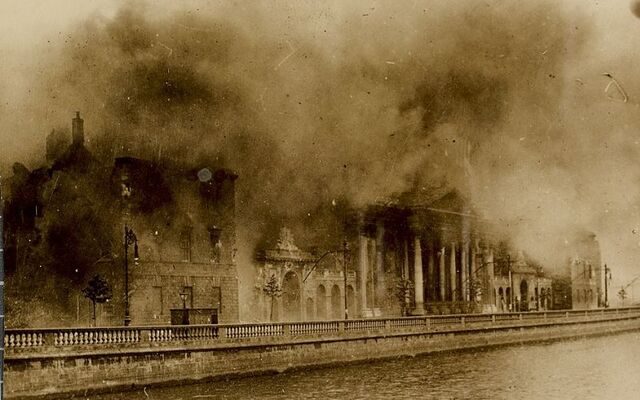
The Four Courts in Dublin during the Battle of Dublin. National Library of Ireland / Public Domain
In the early hours of June 28, 1922, the bombardment of Dublin’s Four Courts marked the explosive start of the Irish Civil War. What followed was a tragic battle that razed history, divided a nation, and altered the course of Ireland forever.
At 3:40 a.m. on June 28, 1922, the insurgents in the Four Courts were given an ultimatum to surrender by troops of the Free State under the command of Michael Collins. When they refused, firing commenced 20 minutes later and the Irish Civil War had begun.
Eighteen-pounder guns "borrowed" from the British Army were located at Bridgefort Street, at the corner of Usher’s Quay. The men operating these guns, under the command of Emmet Dalton, fired the shots to shell the Four Courts. Artillery was also located at Winetavern Street and Merchant’s Quay. The first shots fired on the Four Courts came from here at 4.29 am. Cpt. Johnny Doyle fired the first round.
Single rounds were fired at fifteen-minute intervals and a total of 375 shells were fired before the garrison surrendered. Free State troops also placed 18-pounder guns on Wood Quay to shell the Courts. The British did not trust the Irish with high explosive shells and issued only shrapnel rounds, which were mostly ineffective against the stone walls of the building.
Éamon de Valera quickly described the members of the Four Courts garrison as the "best and bravest of our nation" and joined the IRA/Republicans as an unranked soldier after the bombardment of the Four Courts.
Twelve members of the IRA/Republican Executive were in the Four Courts when it was attacked – Liam Lynch and Liam Deasy left the building shortly before the attack and were arrested but then released because Free State General Richard Mulcahy hoped they would be an influence for peace.
Lynch went across to the Clarence Hotel on Wellington Quay. He was sleeping there when the attack on the Four Courts commenced. Lynch left to go to the south and was captured with Liam Deasy. They were taken for questioning by Eoin O’Duffy, who again let them go. They subsequently went to Kingsbridge Station and caught a train south with Seámus Robinson. From southwest Ireland, Lynch and Deasy became the leaders of the anti-Treaty forces during the Civil War.
O'Malley takes command and the Four Courts falls
On 29 June, Ernie O’Malley took over command in the Four Courts. By that time, the shelling had caused the Courts to catch fire. In addition, orders arrived from Oscar Traynor, IRA commander in Dublin, for the Four Courts garrison to surrender as he could not reach their position to help them. At 3:30 pm on 30 June, O’Malley surrendered the Four Courts to Brigadier General Paddy Daly.
Several hours before the surrender, the Irish Public Record Office, located in the western block of the Four Courts, which had been used as an ammunition store by the garrison, was the centre of a huge explosion, blowing to pieces one thousand years of Irish state and religious archives. Forty advancing Free State troops were badly injured.
It was alleged by the National Army Headquarters that the Anti-Treaty forces deliberately booby-trapped the Public Record Office to kill advancing Free State troops. Tim Healy, a government supporter, later alleged that the explosion was the result of land mines laid before the surrender, which exploded after the surrender. However, a study of the battle concluded that the explosion was caused by fires ignited by the shelling of the Four Courts, which eventually reached two truckloads of gelignite in the IRA munitions factory.
Casualties and prisoners
Joe Considine, Seán Cusack and Thomas Wall were killed in the Four Courts bombardment.
One hundred prisoners were taken sent to Mountjoy Prison, among them Rory O’Connor, Liam Mellows, Joe McKelvey and Dick Barrett. These four were executed in Mountjoy Prison on 8 December 1922 in reprisal for the shooting death of TD Seán Hales on 7 December. Ernie O’Malley was among a group who escaped on the way to Mountjoy.
It should be noted that the gun carriage on which Michael Collins’s casket was transported to Glasnevin Cemetery was borrowed from the British and was one of the carriages used in the bombardment of the Four Courts in June. The Free State Government specially purchased four black artillery horses from the British to pull the caisson to Glasnevin.
For more on the Irish Rebellion period from 1916 to 1923, read "The Shadow War and The Terror War."
This article was submitted to the IrishCentral contributors network by a member of the global Irish community. To become an IrishCentral contributor click here.
![]()
Quiz:
How Well Do You Know Your Éire?
1. What battle ended the Nine Years’ War in 1601?
A) Clontarf
B) Kinsale
C) Boyne
D) Aughrim
2. Which High King led the Irish at the Battle of Clontarf in 1014?
A) Cú Chulainn
B) Brian Boru
C) Niall of the Nine Hostages
D) Diarmait Mac Murchada
3. In which century was the Book of Kells created?
A) 6th
B) 7th
C) 8th
D) 9th
4. What name was given to Irish soldiers who served in European armies after the Williamite Wars?
A) The Fighting Irish
B) The Wild Geese
C) The Gael Guard
D) The Celts Abroad
5. Who was the first female president of Ireland?
A) Mary McAleese
B) Countess Markievicz
C) Mary Robinson
D) Joan Burton
Answers below
![]()
Tommy Mac here.
For years I have been asking my readers to submit
some of their own memories on various subjects.
But, I have only had a handful of replies over all those years.
Come on now!
I'm sure many of you have recipies, memories of your own,
or stories handed down that would be of interest.
Please.....
Send in some of your actual memories of family stories to share with everyone.
If you don't want your name to appear the let me know.
Send them to me, Tommy Mac at Fireny@aol.com
![]()
Quiz Answers:
1: B) Kinsale
2: B) Brian Boru
3: D) 9th
4: B) The Wild Geese
5: C) Mary Robinson
![]()
News of Interest,,,,,
"Aspirations are not enough" -
Leo Varadkar speaks on Irish Unity in West Belfast
IrishCentral Contributor Martin Burns on Leo Varadkar's recent talk, where he urged practical steps toward Irish unity in a post-political reinvention.
Martin Burns Contributor @IrishCentral Jun 24,
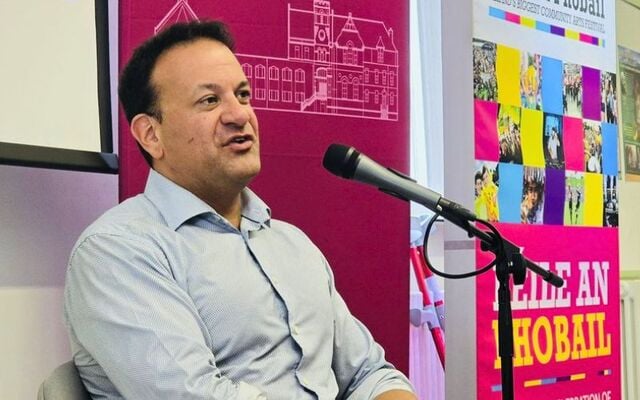
Leo Varadkar speaks at St. Mary’s College in West Belfast. Féile an Phobai / Martin Burns Former
Taoiseach Leo Varadkar addressed a packed hall at an event hosted by Ireland’s Future and Féile an Phobail. His appearance and his message marked a striking shift from his party’s past, signaling a deeper engagement with the idea of a New Ireland.
On an unbelievably warm and sunny Friday afternoon, former Irish Taoiseach (Prime Minister) Leo Varadkar came to St. Mary’s College in West Belfast to headline an event produced by the groups Ireland’s Future and Féile an Phobail (a West Belfast community organization), on June 20.
It was a testament to the power of the issue and earlier events put on by Ireland’s Future that the crowd at the event took over an entire lecture hall and most of a nearby overflow hall.
Everything in Ireland has a back story to it, and the back story here is that Varadkar’s former political party, Fine Gael, is traditionally seen as not very committed to the idea of Irish unity. So, it was quite significant that in West Belfast, in what is probably the heart of the Sinn Féin/Irish nationalist community, such a good crowd turned out.
Varadkar retired from politics after the Irish elections in 2025. Since he left office, Varadkar has become more outspoken on Irish unity than he ever was in office. Emma Little-Pengelly, Northern Ireland’s Deputy First Minister, said recently that Varadkar was “reinventing himself” with his increased support for Irish unity. In his remarks, Varadkar tacitly acknowledged his increased enthusiasm for Irish Unity.
Wherever you stand in Irish politics, you have to acknowledge that Varadkar is an experienced politician. He knows how to build coalitions and count votes. Early on in his remarks, which were expertly moderated by Reverend Karen Sethuraman of Ireland’s Future, Varadkar pointed out that “nothing in politics is inevitable” and that this includes a united Ireland.
The implication was clear: if there is to be a united Ireland, it will take work.
"Aspiration isn’t enough"
In what could easily be regarded as a criticism of his time in office, Varadkar said, "Just saying it [a united Ireland] is an aspiration isn’t enough anymore.
"I have proposed the establishment of a forum for parties interested in talking about unity. I hope, at some point, in the term of this Government, that decision will be taken.”
In quite clear and specific language, Varadkar said that a united Ireland did not mean that the Irish Republic would be taking over the North. Instead, Varadkar argued that what he and others at Ireland’s Future were talking about was a New Ireland.
This would entail a new health care and education system and economic integration. The key challenge that supporters of a New Ireland face is to make the benefits tangible to the people of Ireland, both in Northern Ireland and in the Republic of Ireland. For example, the economy in a New Ireland will mean an economy that will allow your children to live in the place they have grown up and a new Ireland will mean a healthcare system that delivers quality care for all.
The most significant part of Varadkar’s remarks was when he argued that while politicians and political parties would be very important in creating and winning a referendum for Irish unity, in the end, it would be a grassroots movement that would win any referendum on Irish unity.
To back up his argument, Varadkar pointed to the marriage equality referendum in 2015 and the abortion referendum in 2018. Both referendums passed by wide majorities. By citing these examples, Varadkar is implicitly arguing that for a New Ireland to become a reality, you will need to have a significant majority. The Good Friday/Belfast Agreement implies that all that is needed for a successful referendum is 50 percent plus one vote.
Perhaps the most significant part of Varadkar’s remarks was when he described the current debate over Irish unity as something that was the logical outcome of the Good Friday/Belfast Agreement. Varadkar’s remarks here make a lot of sense.
They are also a good reminder that Irish unity will take work by politicians and grassroots work by activists.
The fact that you have a former Fine Gael taoiseach discussing Irish unity before a packed audience in West Belfast is a sure sign that there is a conversation going on in both Northern Ireland and the Irish Republic about Irish unity.
This article was submitted to the IrishCentral contributors network by a member of the global Irish community. To become an IrishCentral contributor click here.
![]()
Billionaire Michael Bloomberg tells Dublin crowd
of the two sides to Donald Trump
Michael Bloomberg told a Dublin audience that he is not a supporter of the US administration, though he's known Donald Trump for decades.
Niamh Walsh @ Extra.ie Jun 26, 2025

September 11, 2024: Former NYC Mayor Michael Bloomberg and former US President Donald Trump shake hands at the annual 9/11 Commemoration Ceremony at the National 9/11 Memorial and Museum in New York City. Getty Images
Donald Trump, Brexit, and the ongoing conflict in the Middle East topped the agenda as billionaire media baron Michael Bloomberg chaired a global conference in Dublin this week.
A former mayor of New York City, Mr. Bloomberg jetted into the capital to officially open his media agency’s new offices at One Charlemont Square. And the real estate investor sat down for an in-depth chat with Minister for Finance Paschal Donohue on his whistle-stop visit to the city. Bloomberg, whose moniker is synonymous with the world of financial media, spoke about the fiscal situation on both sides of the
Atlantic, saying Donald Trump and Brexit, and now the war in the Middle East, have been a cause of massive disruption.
Speaking at the packed conference, Mr. Bloomberg said America is now in a difficult situation in terms of its international relations following the bombing of nuclear sites in Iran, which had surprised him as much as anyone.
"America has spent the last 70 years trying to build relationships with other countries – and we benefit, and those other countries all benefit, and here we’re throwing away a lot of that, which I can’t explain," said Mr. Bloomberg.
"But that’s what the [US] administration is doing, and I was not a supporter of this administration, although I’ve known Donald Trump for 30-40 years. When I was mayor of New York, he was a real estate developer in the city, and only went bankrupt six times."
Mr. Bloomberg went on to detail two sides to Trump – one in which you can have a cordial relationship and see the President as a "pleasant guy," while also seeing a side that you vehemently disagree with.
"If you sat and had dinner with him, you’d walk away saying 'yeah, I had a good time.' Having said that, I don’t agree with his policies at all."
The businessman stressed, however, that he is careful to ensure that Bloomberg news service has the same number of conservatives and liberals on its editorial staff. He has not visited the White House, as he doesn’t want anybody to say that "we’re kissing the ring."
He further stressed that he wanted his news service to stay politely impartial saying; "because I think that’s what our customers want, and that’s what the world deserves from a news organisation."
On his news agency’s growth in Europe, Mr. Bloomberg says he believes Ireland has the potential for exponential growth. "We have 150 people in our office here now, and it’s growing.
We’re looking for another 25 people, probably mostly in engineering."
He also commented on Ireland’s recent economic success, saying that in his estimation the country had benefited from Brexit, which he described as "the single stupidest thing any country has ever done, and it’s hard to believe how they did it."
*This article was originally published on Extra.ie.
![]()
![]()
A Little Humor 
Times when you might be excused for using foul language

![]()
Funny Headlines

Duh!

![]()
A few "Funny Lines"
Going to church doesn't make you a Christian any more than standing in a garage makes you a car.
A diplomat is someone who tells you to go to **** in such a way that you look forward to the trip.
Hospitality is making your guests feel at home even when you wish they were.
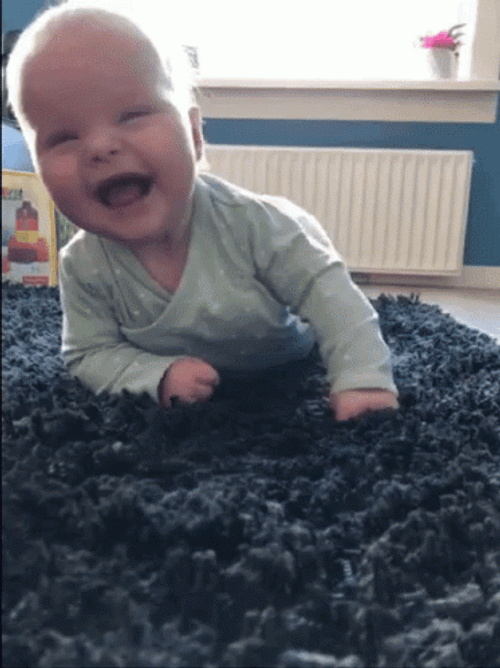
![]()

Church Bloopers
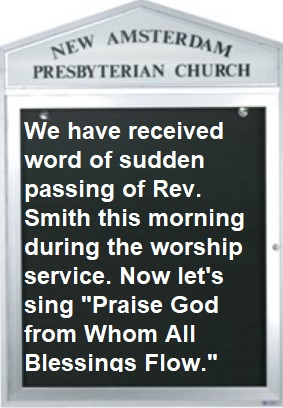
![]()
From my wife Donna




![]()
Every cops dream chase
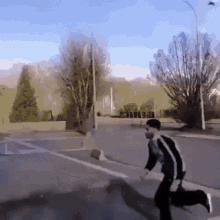
![]()
Only in Ireland

![]()
Many News items, stories, recipies, jokes and poems are taken from these sites with their generous permission.
Please support them my clicking on the links below and sign up for their free newsletter.
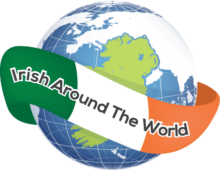 .....
..... ....
....
Subscribe
to IrishCentral  ..
.. ....
....

 .........
.........![]() ......
......
![]()
Welcome to
Tír na mBláth
(Land of Flowers)
Tír na mBláth is one of hundreds of branches throughout the world of Comhaltas Ceoltóirí Éireann (CCÉ) pronounced "kol-tus
kyol-tori air-in", the largest group involved in the preservation of
Irish music, dance and song.
throughout the world of Comhaltas Ceoltóirí Éireann (CCÉ) pronounced "kol-tus
kyol-tori air-in", the largest group involved in the preservation of
Irish music, dance and song.
Our board and membership is made up of Irish, Irish descendants, and all those who support, celebrate and take pride in the preservation of Irish culture.
We also aim to promote good will and citizenship.
Interested in belonging to Tír na mBláth? Feel free to download our membership form
Facebook page is at Tír na mBláth
Our meetings and several events are held at Tim Finnegan's Irish Pub in Delray Beach Florida.
![]()
Well, that's it for this week.
Slán abhaile
Pronunciation: slawn a-wol-ya
Meaning: Safe Home
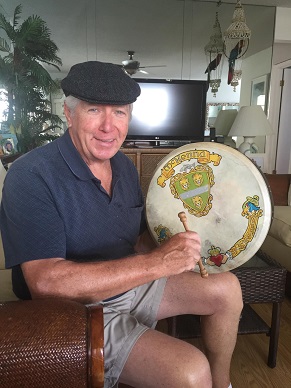 ...
...
Sláinte, Tom Guldner (Tommy Mac)
Slán agus beannacht, (Good-bye and blessings)
Number of visitors to this website since Sept 2022
..